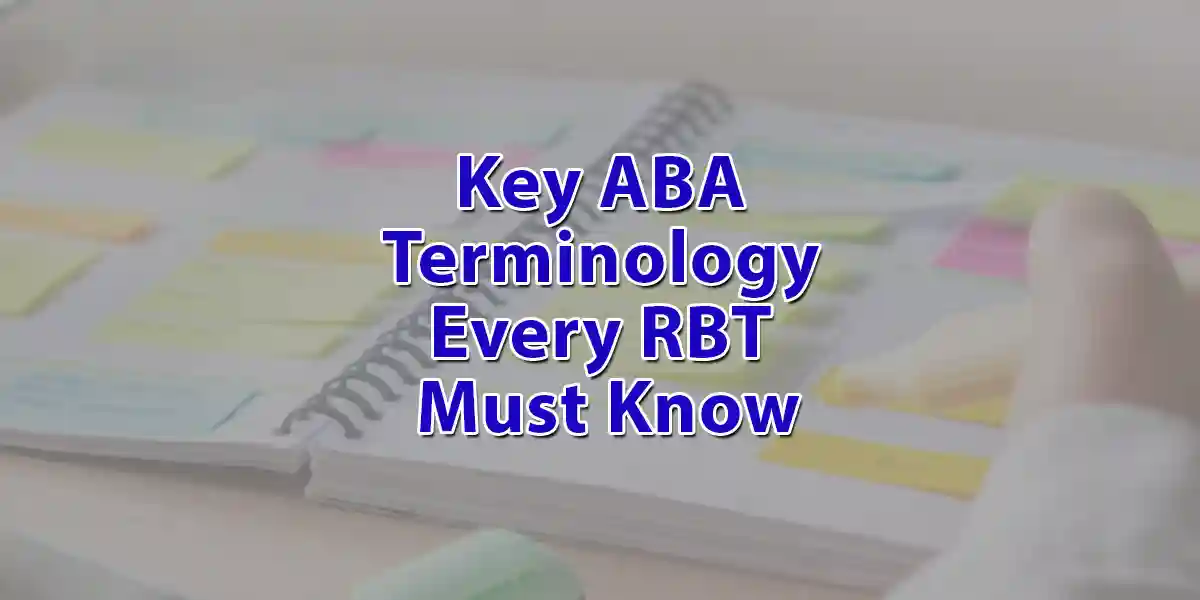Learning the language of ABA can be akin to learning a new dialect, yet these terms provide the key to providing truly effective support. Every Registered Behavior Technician leans on this shared vocabulary to ensure teamwork, clarity, and meaningful outcomes. Imagine a toolbox: without understanding the names and purposes of each tool, even a skilled craftsman may become confused. That’s precisely how it works for RBTs—these terms are your go-to tools for helping clients thrive.
Mastering these words isn’t just about passing an exam; it’s about being able to spot what’s happening, describe it clearly, and collaborate with your team. Having the right language at your disposal changes everything, whether you’re tracking progress or figuring out why a client behaves a certain way. Let’s get into the must-know ABA terms every RBT should use confidently on the job.
Applied Behavior Analysis: The Core Concept
Everything starts with Applied Behavior Analysis itself. ABA is a scientific approach focused on understanding and changing behavior. Instead of guessing or relying on gut feelings, RBTs use data-driven strategies grounded in evidence. The aim? To increase helpful behaviors and reduce those that get in the way of learning or daily life.
ABA breaks behavior down into parts you can observe and measure. That means you’re not just seeing a child “act out”—you’re noting what happened before, what exactly they did, and what happened right after. This process helps you figure out patterns, track progress, and celebrate victories big and small.
Behavior: Definition and Real-World Examples
When someone mentions “behavior” in an ABA setting, it means anything a person does that you can see or hear. It’s more than just tantrums or outbursts—behavior includes speaking, pointing, picking up a toy, or even making eye contact. If you can count it, describe it, or measure how long it lasts, it counts as behavior.
Say a child claps their hands when they hear music. Or a teen completes a math problem when prompted. Both are behaviors. This clear definition helps RBTs stay objective, avoid assumptions, and collect solid data. Defining behavior in specific terms, such as “he left his seat without permission five times,” significantly contributes to the creation of effective plans.
Antecedent: Understanding What Comes Before
“Antecedent” is just a fancy way to say, “What happened right before?” It’s a key piece of the puzzle when you’re figuring out why someone does what they do. Think of it like the first domino in a chain reaction—the event or situation that sets off a behavior.
Maybe a teacher gives a difficult assignment, and right after, a student starts tapping their pencil or asks to use the bathroom. The assignment is the antecedent. Knowing this helps RBTs spot patterns and adjust the environment to set up clients for success. Changing antecedents can prevent challenging behaviors before they even start.
Consequence: What Follows a Behavior
If antecedents are the set-up, consequences are the punchline—the immediate result after a behavior happens. A consequence could be a reaction from someone else, a change in the environment, or something internal like relief. Consequences are powerful; they influence whether a behavior is likely to happen again.
A simple example: A child says “please,” and an adult hands over a toy. The toy is the consequence, and if the child likes this outcome, you’ll probably see more polite requests. RBTs pay close attention to the consequences to understand what’s keeping certain behaviors going or what might help encourage new ones.
Reinforcement: Positive and Negative Explained
Reinforcement is all about making behaviors happen more often. There are two types, and both are misunderstood outside of ABA:
- Positive Reinforcement: Adding something good after a behavior. Think praise, tokens, or access to a favorite activity. For instance, a student gets extra recess time for finishing their homework.
- Negative Reinforcement: Taking something unpleasant away after a behavior. Imagine a student raises their hand and, as a result, doesn’t have to do an unwanted chore. The relief acts as reinforcement.
Notice, neither one means “good” or “bad”—it’s just about whether the behavior increases. RBTs carefully choose reinforcers that are meaningful for each client, making sure progress feels rewarding.
Punishment: Myths, Facts, and Proper Use
Punishment, in ABA, isn’t about being harsh or punitive—it’s simply anything that makes a behavior less likely to happen again. There are two main types:
- Positive Punishment: Adding something after a behavior that decreases the chance it will occur again, like a gentle reminder or extra work after misbehavior.
- Negative Punishment: Taking something away, such as losing access to a favorite game after a rule is broken.
Effective RBTs rarely rely on punishment alone. Instead, the focus stays on teaching new skills and using reinforcement. Punishment should always be the last resort, used ethically and only when necessary, with plenty of documentation and oversight.
Function of Behavior: The “Why” Behind Actions
Every behavior serves a purpose, or “function.” Understanding the function is similar to having a cheat code for problem-solving. The main categories are:
- Attention: The person wants interaction (positive or negative).
- Escape/Avoidance: The person tries to get away from something (work, noise, demand).
- Access to Tangibles: The person wants a specific item or activity.
- Sensory/Automatic: The behavior itself feels good or relieves discomfort.
For example, if a student shouts out in class and their classmates laugh, the function of this behavior might be to gain attention. Pinpointing the function helps RBTs create interventions that meet the client’s needs in more appropriate ways.
Prompting: Levels and Strategies for Success
Prompts are supports given to help clients complete a task or use a skill they haven’t yet mastered. There’s an art to prompting: give just enough help to encourage success, but fade out support over time so the person learns independence.
Types of prompts include:
- Physical prompts (guiding a hand)
- Verbal prompts (giving a hint or instruction)
- Gestural prompts (pointing or nodding)
- Visual prompts (pictures, schedules)
Choosing the right prompt—and knowing when to fade it—is critical for skill building. RBTs always aim to “do with, not for,” giving the client space to shine as they learn.
Shaping and Chaining: Building Complex Skills
Some skills are too big to learn all at once. Shaping means reinforcing small steps toward a final behavior, celebrating each tiny victory along the way. If a child is learning to say “hello,” you might start by reinforcing a wave, then a sound, then the whole word.
Chaining breaks a task into steps. There are two main strategies:
- Forward chaining: Teach the first step, then the next, building in order.
- Backward chaining: Teach the last step first, then add earlier steps so the client always finishes the task successfully.
Both techniques help clients tackle tasks that might otherwise feel overwhelming, one manageable step at a time.
Data Collection: Keeping Track the Right Way
Accurate data is the backbone of ABA. RBTs track behaviors, skill progress, and how interventions are working. Data collection methods include:
- Frequency recording: How many times a behavior happens.
- Duration recording: How long a behavior lasts.
- Interval recording: Whether a behavior happens within set time blocks.
- ABC recording: Documenting the Antecedent, Behavior, and Consequence for each event.
Consistent data allows teams to spot trends, make informed decisions, and celebrate every bit of growth, no matter how small.
Generalization and Maintenance: Making Skills Stick
A skill mastered in therapy doesn’t mean much if it only happens there. Generalization is the process of making sure new skills show up in many places—with different people, in new settings, and even when routines change. Maintenance is about keeping those skills going over time.
RBTs plan for generalization from the start, mixing up environments and people, and practicing skills in real-world scenarios. Maintenance strategies include regular review, ongoing reinforcement, and family involvement.
Extinction: Reducing Unwanted Behaviors
Extinction in ABA means stopping reinforcement for a behavior so it fades out over time. For example, if a student shouts out to get attention and no one responds, the behavior may decrease. It’s important to pair extinction with teaching new skills and reinforcing those instead.
Extinction isn’t instant, and sometimes, behaviors get worse before they improve—a phenomenon called an “extinction burst.” RBTs prepare families and teams for this, focusing on consistency and patience.
Ethics and Professional Conduct: RBT Standards
RBTs follow strict ethical guidelines to protect clients’ dignity, privacy, and well-being. The Behavior Analyst Certification Board (BACB) sets clear rules: always prioritize the client’s best interests, respect cultural differences, maintain confidentiality, and never use interventions that could cause harm.
Ethical practice also means keeping up with training, being honest about your skills, and consulting supervisors when challenges arise. Every interaction is guided by a commitment to professionalism and respect.
Conclusion: Bringing ABA Terminology Into Practice
Familiarity with key ABA terms is the foundation of confident, effective work as an RBT. From understanding the building blocks of behavior to tracking progress with precision, each word on this list represents a step toward positive change. These aren’t just technical definitions—they’re the language of hope, progress, and possibility.
When every member of a team speaks the same language, communication flows, mistakes drop, and clients get the support they deserve. So, whether you’re just starting your RBT journey or looking to level up your expertise, keep these terms close. These terms serve as your guide, your compass, and your hidden tool for consistently making a significant impact.

